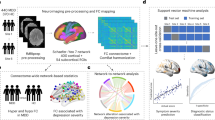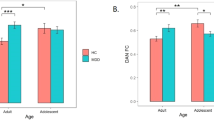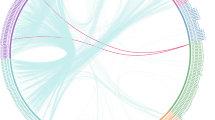Abstract
Major depressive disorder (MDD) often emerges during adolescence, a critical period of brain development. Recent resting-state fMRI studies of adults suggest that MDD is associated with abnormalities within and between resting-state networks (RSNs). Here we tested whether adolescent MDD is characterized by abnormalities in interactions among RSNs. Participants were 55 unmedicated adolescents diagnosed with MDD and 56 matched healthy controls. Functional connectivity was mapped using resting-state fMRI. We used the network-based statistic (NBS) to compare large-scale connectivity between groups and also compared the groups on graph metrics. We further assessed whether group differences identified using nodes defined from functionally defined RSNs were also evident when using anatomically defined nodes. In addition, we examined relations between network abnormalities and depression severity and duration. Finally, we compared intranetwork connectivity between groups and assessed the replication of previously reported MDD-related abnormalities in connectivity. The NBS indicated that, compared with controls, depressed adolescents exhibited reduced connectivity (p<0.024, corrected) between a specific set of RSNs, including components of the attention, central executive, salience, and default mode networks. The NBS did not identify group differences in network connectivity when using anatomically defined nodes. Longer duration of depression was significantly correlated with reduced connectivity in this set of network interactions (p=0.020, corrected), specifically with reduced connectivity between components of the dorsal attention network. The dorsal attention network was also characterized by reduced intranetwork connectivity in the MDD group. Finally, we replicated previously reported abnormal connectivity in individuals with MDD. In summary, adolescents with MDD show hypoconnectivity between large-scale brain networks compared with healthy controls. Given that connectivity among these networks typically increases during adolescent neurodevelopment, these results suggest that adolescent depression is associated with abnormalities in neural systems that are still developing during this critical period.
Similar content being viewed by others
Log in or create a free account to read this content
Gain free access to this article, as well as selected content from this journal and more on nature.com
or
References
Bai F, Shu N, Yuan Y, Shi Y, Yu H, Wu D et al (2012). Topologically convergent and divergent structural connectivity patterns between patients with remitted geriatric depression and amnestic mild cognitive impairment. J Neurosci 32: 4307–4318.
Bassett DS, Bullmore E (2006). Small-world brain networks. Neuroscientist 12: 512–523.
Birmaher B, Arbelaez C, Brent D (2002). Course and outcome of child and adolescent major depressive disorder. Child Adolesc Psychiatr Clin N Am 11: 619–637.
Birmaher B, Brent D (2007). Practice parameter for the assessment and treatment of children and adolescents with depressive disorders. J Am Acad Child Psychiatry 46: 1503–1526.
Bohr IJ, Kenny E, Blamire A, O'Brien JT, Thomas AJ, Richardson J et al (2012). Resting-state functional connectivity in late-life depression: higher global connectivity and more long distance connections. Front Psychiatry 3: 116.
Bullmore ET, Suckling J, Overmeyer S, Rabe-Hesketh S, Taylor E, Brammer MJ (1999). Global, voxel, and cluster tests, by theory and permutation, for a difference between two groups of structural MR images of the brain. IEEE Trans Med Imaging 18: 32–42.
Connolly CG, Wu J, Ho TC, Hoeft F, Wolkowitz O, Eisendrath S et al (2013). Resting-state functional connectivity of subgenual anterior cingulate cortex in depressed adolescents. Biol Psychiatry 74: 898–907.
Craddock RC, James GA, Holtzheimer PE III, Hu XP, Mayberg HS (2011). A whole brain fMRI atlas generated via spatially constrained spectral clustering. Hum Brain Mapp 33: 1914–1928.
Cullen KR, Westlund MK, Klimes-Dougan B, Mueller BA, Houri A, Eberly LE et al (2014). Abnormal amygdala resting-state functional connectivity in adolescent depression. JAMA Psychiatry 71: 1138–1147.
Davey CG, Harrison BJ, Yücel M, Allen NB (2012). Regionally specific alterations in functional connectivity of the anterior cingulate cortex in major depressive disorder. Psychol Med 42: 2071–2081.
Fair DA, Cohen AL, Dosenbach NUF, Church JA, Miezin FM, Barch DM et al (2008). The maturing architecture of the brain's default network. Proc Natl Acad Sci USA 105: 4028–4032.
Fair DA, Cohen AL, Power JD, Dosenbach NUF, Church JA, Miezin FM et al (2009). Functional brain networks develop from a “local to distributed” organization. PLoS Comput Biol 5: e1000381.
Fair DA, Dosenbach NUF, Church JA, Cohen AL, Brahmbhatt S, Miezin FM et al (2007). Development of distinct control networks through segregation and integration. Proc Natl Acad Sci USA 104: 13507–13512.
Fornito A, Zalesky A, Breakspear M (2013). Graph analysis of the human connectome: promise, progress, and pitfalls. Neuroimage 80: 426–444.
Gong Q, He Y (2015). Depression, neuroimaging and connectomics: a selective overview. Biol Psychiatry 77: 223–235.
Gordon EM, Laumann TO, Adeyemo B, Huckins JF, Kelley WM, Petersen SE (2014). Generation and evaluation of a cortical area parcellation from resting-state correlations. Cereb Cortex 26: 288–303.
Gotlib IH, Joormann J (2010). Cognition and depression: current status and future directions. Annu Rev Clin Psychol 6: 285–312.
Grayson DS, Ray S, Carpenter S, Iyer S, Dias TGC, Stevens C et al (2014). Structural and functional rich club organization of the brain in children and adults. PLoS One 9: e88297.
Greicius MD, Flores BH, Menon V, Glover GH, Solvason HB, Kenna H et al (2007). Resting-state functional connectivity in major depression: abnormally increased contributions from subgenual cingulate cortex and thalamus. Biol Psychiatry 62: 429–437.
Ho TC, Connolly CG, Blom EH, LeWinn KZ, Strigo IA, Paulus MP et al (2015). Emotion-dependent functional connectivity of the default mode network in adolescent depression. Biol Psychiatry 78: 635–646.
Jamison DT, Breman JG, Measham AR, Alleyne G, Claeson M, Evans DB et al (2006) Disease Control Priorities in Developing Countries. World Bank Publications: Washington, DC, USA.
Jin C, Gao C, Chen C, Ma S, Netra R, Wang Y et al (2011). A preliminary study of the dysregulation of the resting networks in first-episode medication-naive adolescent depression. Neurosci Lett 503: 105–109.
Kaiser RH, Andrews-Hanna A-HJ, Wager WT, Pizzagalli PD (2015). Large-scale network dysfunctionin major depressive disorder: a meta-analysis of resting-state functional connectivity. JAMA Psychiatry 72: 603–611.
Kelly AMC, Di Martino A, Uddin LQ, Shehzad Z, Gee DG, Reiss PT et al (2009). Development of anterior cingulate functional connectivity from late childhood to early adulthood. Cereb Cortex 19: 640–657.
Kerestes R, Davey CG, Stephanou K, Whittle S, Harrison BJ (2010). Functional brain imaging studies of youth depression: a systematic review. Neuroimage Clin 4: 209–231.
Kessler RC, Walters EE (1998). Epidemiology of DSM-III-R major depression and minor depression among adolescents and young adults in the National Comorbidity Survey. Depress Anxiety 7: 3–14.
Korgaonkar MS, Fornito A, Williams LM, Grieve SM (2014). Abnormal structural networks characterize major depressive disorder: a connectome analysis. Biol Psychiatry 76: 567–574.
Lewinsohn PM, Rohde P, Seeley JR (1998). Major depressive disorder in older adolescents: prevalence, risk factors, and clinical implications. Clin Psychol Rev 18: 765–794.
Lord A, Horn D, Breakspear M, Walter M (2012). Changes in community structure of resting state functional connectivity in unipolar depression. PLoS One 7: e41282.
Meng C, Brandl F, Tahmasian M, Shao J, Manoliu A, Scherr M et al (2014). Aberrant topology of striatum's connectivity is associated with the number of episodes in depression. Brain 137: 598–609.
Menon V (2011). Large-scale brain networks and psychopathology: a unifying triple network model. Trends Cogn Sci 15: 483–506.
Menon V (2013). Developmental pathways to functional brain networks: emerging principles. Trends Cogn Sci 17: 627–640.
Meskaldji DE, Fischi-Gomez E, Griffa A, Hagmann P, Morgenthaler S, Thiran J-P (2013). Comparing connectomes across subjects and populations at different scales. Neuroimage 80: 416–425.
Miller GA, Chapman JP (2001). Misunderstanding analysis of covariance. J Abnorm Psychol 110: 40.
Mulders PC, van Eijndhoven PF, Schene AH, Beckmann CF, Tendolkar I (2015). Resting-state functional connectivity in major depressive disorder: a review. Neurosci Biobehav Rev 56: 330–344.
Pannekoek JN, van der Werff SJA, Meens PHF, van den Bulk BG, Jolles DD, Veer IM et al (2014). Aberrant resting-state functional connectivity in limbic and salience networks in treatment-naïve clinically depressed adolescents. J Child Psychol Psychiatry 55: 1317–1327.
Power JD, Fair DA, Schlaggar BL, Petersen SE (2010). The development of human functional brain networks. Neuron 67: 735–748.
Reynolds WM, Mazza JJ (1998). Reliability and validity of the Reynolds Adolescent Depression Scale with young adolescents. J School Psychol 36: 295–312.
Rubinov M, Bullmore E (2013). Fledgling pathoconnectomics of psychiatric disorders. Trends Cogn Sci 17: 641–647.
Sacchet MD, LaPlante RA, Wan Q, Pritchett DL, Lee AKC, Hamalainen M et al (2015a). Attention drives synchronization of alpha and beta rhythms between right inferior frontal and primary sensory neocortex. J Neurosci 35: 2074–2082.
Sacchet MD, Prasad G, Foland-Ross LC, Thompson PM, Gotlib IH (2014). Elucidating brain connectivity networks in major depressive disorder using classification-based scoring. Proc IEEE Int Symp Biomed Imaging 11: 592–595.
Sacchet MD, Prasad G, Foland-Ross LC, Thompson PM, Gotlib IH (2015b). Support vector machine classification of major depressive disorder using diffusion-weighted neuroimaging and graph theory. Front Psychiatry 6: 21.
Sheline YI, Price JL, Yan Z, Mintun MA (2010). Resting-state functional MRI in depression unmasks increased connectivity between networks via the dorsal nexus. Proc Natl Acad Sci USA 107: 11020–11025.
Smyser CD, Inder TE, Shimony JS, Hill JE, Degnan AJ, Snyder AZ et al (2010). Longitudinal analysis of neural network development in preterm infants. Cereb Cortex 20: 2852–2862.
Supekar K, Musen M, Menon V (2009). Development of large-scale functional brain networks in children. PLos Biol 7: e1000157.
Tao H, Guo S, Ge T, Kendrick KM, Xue Z, Liu Z et al (2011). Depression uncouples brain hate circuit. Mol Psychiatry 18: 101–111.
Tuladhar AM, Huurne NT, Schoffelen J-M, Maris E, Oostenveld R, Jensen O (2007). Parieto-occipital sources account for the increase in alpha activity with working memory load. Hum Brain Mapp 28: 785–792.
Tzourio-Mazoyer N, Landeau B, Papathanassiou D, Crivello F, Etard O, Delcroix N et al (2002). Automated anatomical labeling of activations in SPM using a macroscopic anatomical parcellation of the MNI MRI single-subject brain. Neuroimage 15: 273–289.
Veer IM, Beckman CF, van Tol M-J, Ferrarini L, Milles J, Veltman DJ et al (2010). Whole brain resting-state analysis reveals decreased functional connectivity in major depression. Front Syst Neurosci 4: 41.
Weir JM, Zakama A, Rao U (2012). Developmental Risk I: depression and the developing brain. Child Adolesc Psychiatric Clin N Am 21: 237–259.
Ye M, Yang T, Qing P, Lei X, Qiu J, Liu G (2015). Changes of functional brain networks in major depressive disorder: a graph theoretical analysis of resting-state fMRI. PLoS One 10: e0133775.
Yeo BT, Krienen FM, Sepulcre J, Sabuncu MR, Lashkari D, Hollinshead M et al (2011). The organization of the human cerebral cortex estimated by intrinsic functional connectivity. J Neurophysiol 106: 1125–1165.
Yu Q, Peng Y, Mishra V, Ouyang A, Li H, Zhang H et al (2014). Microstructure, length, and connection of limbic tracts in normal human brain development. Front Aging Neurosci 6: 288.
Zalesky A, Fornito A, Bullmore ET (2010). Network-based statistic: Identifying differences in brain networks. Neuroimage 53: 1197–1207.
Zhang J, Wang J, Wu Q, Kuang W, Huang X, He Y et al (2011). Disrupted brain connectivity networks in drug-naive, first-episode major depressive disorder. Biol Psychiatry 70: 334–342.
Acknowledgements
This study was supported by NSF Integrative Graduate Education and Research Traineeship (IGERT) Recipient Award 0801700 to MDS; NSF Graduate Research Fellowship Program (GRFP) DGE-1147470 to MDS; NIMH Neuroscience Research Training Award T32 MH020016 to MDS; NIMH 7R01MH085734, 3R01MH085734-02S1 and R01MH085734-05S1 to TTY; by the Brain and Behavior Research Foundation (formerly NARSAD) to TTY; by the American Foundation for Suicide Prevention PDF-1-064-13 to TCH; by the Swedish Research Council 350-2012-303 to EHB; by the Center of Excellence in Stress and Mental Health; and by a Veteran’s Affairs Merit Grant to ANS. We are grateful to Nisreen Mobayed, Jing Wu, Mary Luna, and Audrey Fortezzo for help with data collection and data management.
Author information
Authors and Affiliations
Corresponding author
Additional information
Supplementary Information accompanies the paper on the Neuropsychopharmacology website
Supplementary information
PowerPoint slides
Rights and permissions
About this article
Cite this article
Sacchet, M., Ho, T., Connolly, C. et al. Large-Scale Hypoconnectivity Between Resting-State Functional Networks in Unmedicated Adolescent Major Depressive Disorder. Neuropsychopharmacol 41, 2951–2960 (2016). https://doi.org/10.1038/npp.2016.76
Received:
Revised:
Accepted:
Published:
Issue date:
DOI: https://doi.org/10.1038/npp.2016.76
This article is cited by
-
A Narrative Review of Loneliness and Brain Health in Older Adults: Implications of COVID-19
Current Behavioral Neuroscience Reports (2022)
-
Altered directed functional connectivity of the right amygdala in depression: high-density EEG study
Scientific Reports (2020)
-
Myelination of the brain in Major Depressive Disorder: An in vivo quantitative magnetic resonance imaging study
Scientific Reports (2017)
-
Inflexible Functional Connectivity of the Dorsal Anterior Cingulate Cortex in Adolescent Major Depressive Disorder
Neuropsychopharmacology (2017)
-
Differential effects of antidepressant treatment on long-range and short-range functional connectivity strength in patients with major depressive disorder
Scientific Reports (2017)



